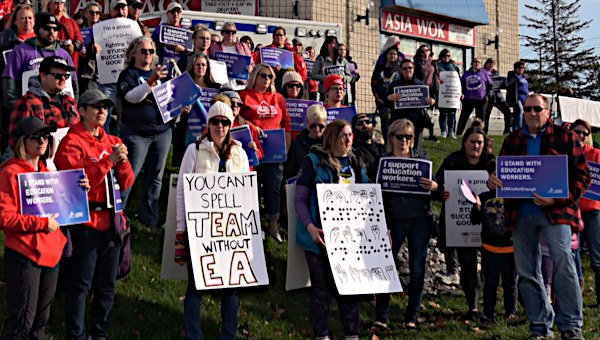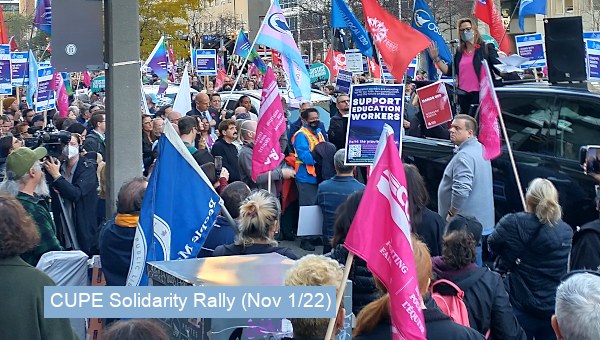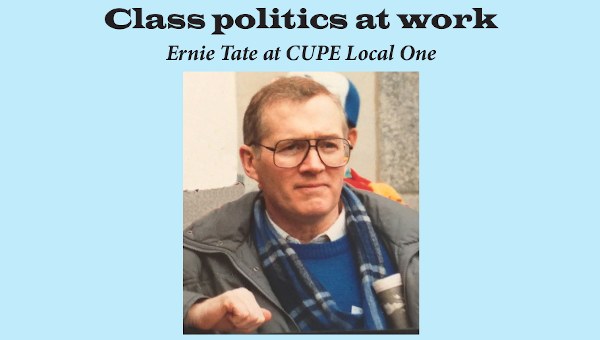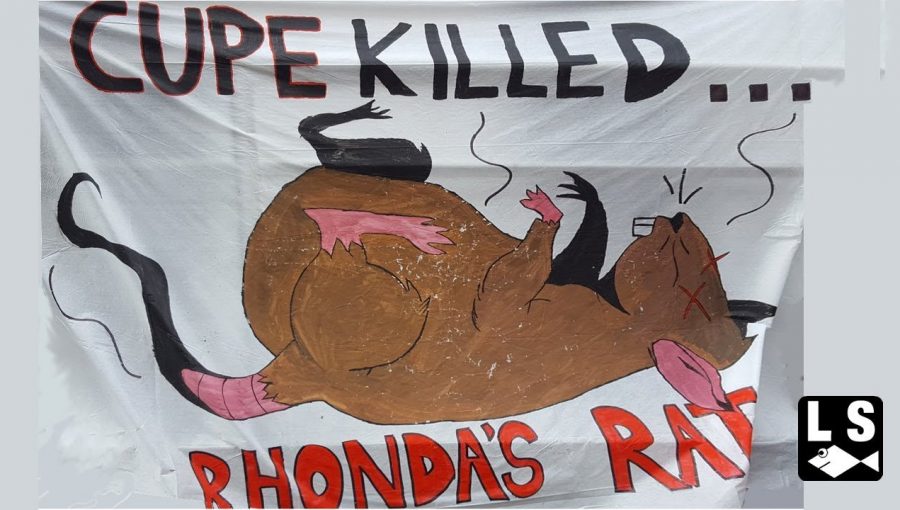Managing the Crisis in Toronto: Class Power and Striking City Workers
After six months of negotiations without a contract and little movement during collective bargaining, City of Toronto workers in CUPE Locals 79 and 416 went on strike on June 22. Local 79 is the largest municipal local in Canada, with a membership of 18,000 although various contingent, seasonal and part-time workers push estimates of membership upwards to 24,000, while Local 416 has approximately 6,200 members. Together, they work in areas of public health, elder care, parks, recreation, water treatment, Emergency Medical Services, as well as housing and court services, road maintenance, animal rescue and waste collection.
Four issues appear crucial: continuation of the wage pattern that has led to settlements with other city workers; employer efforts to eliminate sickday provisions and their banking toward a severance payment upon retirement; a series of concession demands on seniority, job protections and other provisions to increase management flexibility over contracting-out; and continuing struggles over privatization and commercialization of city services. As negotiations continue to stall and the strike looking to persist for some time, the business lobbyists, the press and some right-wing councillors have been urging the provincial government to legislate employees back-to-work.
The strike of city workers is also straining the political coalition that now governs Toronto. Mayor David Miller and his political executive running city services come from the ‘progressive wing’ of Council – a loose alliance between the social democratic NDP, Liberals and a few independents. The electoral basis for this coalition has drawn extensive backing from public sector unions, the Toronto & York Region Labour Council (TYRLC) and progressive urban social movements. They have governed with support of these movements as well, in an informal kind of cooperation. As neoliberal urbanism gained hold, many of these movements also moved away from more radical demands and socialist organizational aspirations.
The ‘Third Way’ progressivism of Miller’s alliance, as opposed to previous right-wing mayors and council members, had initially attempted to forge an alternate development project distinct from the singular business driven model of development at all costs. This alternative has largely been defined by notions of building Toronto as a ‘green economy,’ a ‘creative city,’ a ‘diverse city’ and one with ‘living wages.’
These notions have some merits, but also profound political limits. Notably, the wider economic crisis of capitalism has already upset many of these initiatives and none of them really get at the urban crisis Toronto, and other capitalist cities, face. Moreover, none of these ideas directly confront neoliberal urbanism. Instead, the ‘progressive coalition’ at City Hall is now demanding contractual concessions and demanding that city workers bare the burden of the crisis. None of the progressive councillors are speaking out on the strike and most of the urban social movements – especially the urban ecology movement who have tailed the Miller regime – have been silent. The one exception in speaking out has been radical sections of the anti-poverty movement. For good reason: the poor have seen a continued deterioration of urban services supplied to them over the Miller period (a common feature of the new ‘progressive’ urbanism).
The persistence of neoliberal urbanism in Toronto, despite a new governing coalition at city hall, and new cooperation with urban social movements, raises important questions about extra-local political pressures and constraints that cannot be resolved at the level of city government. It also raises the issue of how these local ‘progressive’ coalitions come to enforce these neoliberal constraints – as has been occurring under the Miller regime in Toronto – rather than build an empowering politics and new political capacities that challenge them – a charge which can be levelled at almost the whole block of progressive councillors in Toronto. In particular, the problem is raised of how these ‘progressive’ political coalitions have come to demand – and actively seek to impose – discipline from workers and unions to cope with these fiscal, political and local constraints while the demands of the capitalist and professional classes are accommodated and incorporated in urban policies. In this case, Toronto civic workers – like workers in auto, Air Canada, and steel – are told they should pay for an economic crisis which they had nothing to do with in the making.
Service Downloading and Local Governments
The point is that a progressive Toronto City council, under pressure from right-wing councillors, political lobbyists and the business community, has come to seek concessions from, and to demonise, its own workers into accepting neoliberal policies. From a long-term perspective, Toronto has made a transition from a heavily manufacturing-based city to the centre of financial capital, producer services and media capitals, and a whole range of low-wage service industries. Like other ‘global cities,’ this has made Toronto highly dependent upon the internationalization of capital – both internationalizing to the world market and entering into Canada.
This is an economic constraint that local politics cannot easily address, and which city council has tended to reinforce in designing practically all of its urban development policies around. This, in turn, truncates ever-more the political vision and ambitions of local government: nothing else can be done except to design Toronto, Inc., as the ‘creative city’ attempting to attract international capital by seeking to make the city attract ‘footloose’ international capital and urban professionals. Other aspects of city services, notably the services provided by urban workers in their daily lives, become less important.
More services, urban amenities and tax breaks are supplied to the capitalist and professional classes and less to community and neighbourhood services and the poor. This is the vision behind why Mayor Miller tells city unions to come to terms with the way the world has changed, and why progressive councillors do not attempt to develop alternative local development strategies to neoliberalism. They accept the capitalist logic that city workers are asking too much.
This truncating of political vision and social ambitions by the ‘progressive coalition’ in Toronto also came to accept the fiscal parameters of neoliberal urbanism. The downloading of service provision and responsibilities has been an integral aspect of neoliberalism – the attempt to move from universal provision of social services at increasingly higher standards to market provision of services at lower standards and with user fees or process attached to them. The objectives of this process have been: the lowering of taxes; the withdrawal of government from the market as much as possible; the lowering of public sector employment and wages; the addition of pressure on private sector wages; and the creation of new profit opportunities for business.
This process started in Canada under Prime Minister Brian Mulroney in the mid-80s with the federal government slowly withdrawing from transfer payments to the provinces in terms of equalization payments but also funding key social programmes. It accelerated under the Liberals in the mid-90s with the Canada Health and Social Transfer (CHST). In turn, the provincial governments offloaded more programmes and funding responsibilities on to the municipalities without matching fiscal support.
This meant, for examples, an inequitable distribution of equalization payments, the retrenchment of the Ontario Drug and Disability benefit and additional social services, offloading increased responsibilities and funding for local airports, water and sewage, public transport and policing, and inadequate support for welfare services delivered by municipalities. The result is that cities have faced intense funding problems in general, and in particular addressing expenditures for welfare, transportation, schools and emergency services. In other words, the main areas of local government spending that involve services provided by city workers have lacked adequate fiscal funding capacities. With this ongoing fiscal insecurity – which minor campaigns by city mayors has led only to minor measures to redress – the City of Toronto marched toward neoliberalism.
When the former six municipalities around Toronto were integrated into the ‘Megacity’ in January 1998, Toronto residents were warned of the serious potential for increasing fiscal problems, as the amalgamation was completed and provincial support fell away.
In 2002, conservative Mayor Mel Lastman attempted to deal with the Toronto fiscal challenge by following the ‘slash and burn’ neoliberalism of the provincial Conservative governments of Mike Harris. This included a plan to massively contract-out and move toward a casualized, seasonal and temporary employment relationship. This led to a strike with city workers. Little more than two-weeks into the strike, with over a million visitors expected for World Youth Day and the Pope, Conservative Premier Ernie Eves legislated CUPE back-to-work. The provincial conciliator assigned to the labour dispute ruled in a way that limited rollbacks of job security and workplace provisions.
Some seven-years later and an economic recession as a functional rationale, a progressive City Council is looking to intensify its attack on labour in order to meet its fiscal challenges – challenges generated by capitalism in economic crisis and the policies of neoliberalism and not city workers. Moreover, because of the inadequate funding of the public sector under neoliberalism, Toronto continues to stare at an estimated infrastructural cost well into the billions with major roads, highways and bridges, water and plumbing, electricity generation and distribution, leisure and recreational facilities, waste management and recycling, all requiring major renovations. As well, Toronto continues to struggle with a decaying transit system, public housing, long-term care, environmental, police, ambulance and fire facilities, as well as community-needs and cultural resources. The chronic underfunding of public assets is part and parcel of the neoliberal city. Concessions from city workers delivering these key services, privatization, public-private-partnerships, increasing commercial tax breaks, rebranding Toronto, policies for a ‘creative city’: none of these will resolve the fiscal problems of the City of Toronto and the general crisis of urban neoliberalism in Canada.
Toronto Fiscal Struggles
The pressures to increase spending by cities have been, therefore, growing. It is growing from the downloading of service provision to municipalities, but also from increasing population growth, the social dislocations from the economic crisis, and the need for greater urban infrastructure as capitalism develops and deploys more and more sophisticated capital goods. Neoliberalism has sought to offload services to cities as a means to reduce redistributional expenditures and state interventions; but it also systematically denies these other pressures on urban expenditures. City spending is up $588-million this year and $904-million over the past two, having jumped $2.25-billion over the past six-years to $8.7-billion for 2009.[1]
There are a few points to consider in how these structural fiscal problems have been addressed by the City of Toronto (with similar attempts in cities across Canada).
First, other levels of government have partly recognized the urban fiscal impasse but done nothing to address it in a fundamental way. In 2007, Torontonians were told that they will have to get used to reduced social services such as clean-up and snow removal, less access to community pools, arenas and centres, decreased waste disposal and water testing, as well as reduced library hours and park improvements as part of sweeping “cost containment” measures to “restore long-term fiscal health” and deal with the City’s $575-million shortfall. Plans included closing all community centres on Mondays, reducing recreational programs and delaying the opening of outdoor ice-rinks. Some of these steps were undertaken. But then emergency funding from the province blocked further cuts. The federal government also transferred some gas tax allocations over to cities for urban infrastructure programmes. The service cuts and ad hoc measures by other governments did not overcome the local budgetary impasse.
Second, Toronto City Council has, on the one hand, implemented a range of consumption based (regressive) flat taxes on all citizens, while, on the other hand, shifting away from commercial property-taxes, undervaluing business land assessments and providing major grants and financial assistance.
In 2008, Toronto City Council found itself again with a growing budget shortfall. Mayor Miller lamented:
“Deep cuts would not have been necessary had the land transfer tax been approved. Do we want to live in a vibrant successful City that’s one of North America’s most important and take its rightful place in the world, or do we want our quality of life to deteriorate?… If you want a great city you have to find the resources to pay for it.”
Under the provisions of the new City of Toronto Act 2006, Miller took the opportunity to institute an array of so-called ‘flat taxes’ in the form of the Municipal Land Transfer Tax (MLTT) ranging from 0.5% to 2% and the Personal Vehicle Ownership Tax (PVOT), which saw municipal vehicle registration fees, in conjunction with already-existing provincial registration fees, introduced.
However, City Councillors also
“approved generous property tax breaks to attract high-paying, knowledge-economy jobs to strategic areas of the city, although the business community is already urging the city to further sweeten the pot.”[2]
These incentives – worth over an estimated $500-million – included “brown-field remediation” (city subsidies, tax incentives and/or deferrals for costly environmental clean-ups of, for example, empty industrial lands), as well as tax incremental equivalent grants (TIEGs), which include rebates and minimal property taxes for major commercial developers. “The plan will pay dividends in the long-term. Once the pie grows we’ll all get a piece of it,” said Councilor Karen Stinz. The economic crisis has, however, wiped out fiscal gains, and these tax measures are quite inadequate with respect to urban needs and fiscal capacity.
Third, there are pressures to renew the contracting-out of city services and work and privatization of some capital assets as a means of temporarily relieving its immediate budgetary ailments. City council continues to raise, and the Toronto Board of Trade lobby for, privatizing Enwave, Toronto Hydro and the Toronto Parking Authority (with an estimated value of over $60-billion in assets).[3] But the actual evidence of outsourcing and privatization in North America suggests that the privatization of formerly public-sector jobs – and the experiences of private sector building projects on urban transport and infrastructure projects in Toronto – has been shown to correlate with more expensive and less efficient goods and services, little public oversight and a lower quality of overall services.[4] The sale of assets and contracting-out can provide short-term fiscal injections, but do not solve the structural urban fiscal crisis.
Fourth, the City is now engaged in its attempt to impose a wage freeze and concessions on its city workers in Locals 416/79 with the idea that reducing its direct wage bill the fiscal problems of Toronto could be eased. But a quite different wage and benefit pattern – in the order of a 3 percent settlement – has already bargained with other municipal Locals, such as the police and firefighters, Toronto Housing Corporation, Toronto Port Authority, Toronto Parking Authority and Enwave. A similar pattern of settlement has been occurring over the last year across Ontario in municipalities. Moreover, the Mayor and Council followed the pattern bringing city councillors salaries to $99, 153 – that’s apart from a $53,000 expense budget – with the Mayor’s salary rising to nearly $167,000.
Jim Stanford, who sat as part of the City of Toronto’s recent independent fiscal review panel, argued, despite being generally well-run at the operational level and comparatively efficient, the City faces an ongoing structural deficit.[5] Furthermore,
“In reviewing financial data on the city’s compensation costs, our report debunked the stereotype that the city’s employees are ‘fat cats’…average compensation for unionized workers (including overtime) was less than $40,000 in 2007.”[6]
Attacking CUPE workers is not going to resolve the urban fiscal crisis, but it is going to intensify the income polarisation of Toronto and deepen neoliberal urbanism.
Conclusion
There is a blatant contradiction in the present demands from employers for concessions from private and public sector workers: the economic crisis has been generated by the inefficiencies and reckless excesses of finance capital, but it is being demanded that workers pay for the crisis while public funds are being used to bail out banks and private companies. Why isn’t Mayor Miller and the ‘progressive coalition’ governing at City Hall – anchored in the municipal NDP – not insisting on the importance of city services, the right of workers to respectable working conditions and pay, and that the corporations and professional classes that benefited from the speculative excesses of Bay Street and corporate Canada pay for the crisis? Why are they not mobilizing its population to put pressure on the provincial and federal governments to address the urban fiscal crisis that has been partly created by their policies? Why is the ‘progressive coalition’ at City Hall not addressing the tax and fiscal structures that now systematically favour commercial and capitalist interests in the city to meet the city’s social needs?
City workers in Locals 79 and 416 are not pursuing new demands or wage patterns not agreed to already. But this struggle is demanding that the ‘progressive coalition’ at City Hall start to battle neoliberal urbanism in Toronto, rather than intensify it. •
Notes
1.
J. Royson, ‘After Years of Wild Spending, How Can Miller Cry Poor?’ Toronto Star, June 18 2009.
2.
A. Hanes, ‘Tax Breaks ‘the right thing to do’: Miller,’ National Post, May 2, 2009.
3.
C. Wilding, ‘Toronto Omimously Near the End of its Fiscal Tether,’ Toronto Star, June 17, 2009.
4.
CUPE-NUPGE-PSAC, Developments in Privitization of Public Services (2006).
5.
J. Stanford, ‘Toronto Fiscal Plan: The View from Inside,’ The Progressive Economics Forum Blog, March 2, 2008.
6. Ibid.





